by Mike Garabedian
One of the most conspicuous pieces from among the dozens of prints featured as part of Mixografia: Est. 1969—the late 2019 retrospective comprising some of the more extraordinary artworks produced by the Los Angeles-based studio over the past five decades—was Untitled Ultra Blue, a 2014 work by London- and Lisbon-based artist Jason Martin. Best known for the gestural, monochromatic paintings he creates by layering acrylic gel medium or oil paint on metallic or plexiglass panels, Martin has been described by one critic as making “richly tactile” and “sumptuous” works that “can resemble sculptural reliefs.” So too with Untitled Ultra Blue, which appears to look something like the most invariant ultramarine frosting imaginable slathered onto bone-white rag paper, folded and furrowed with a large, serrated cake shovel, then hung up on Mixografia’s gallery wall.
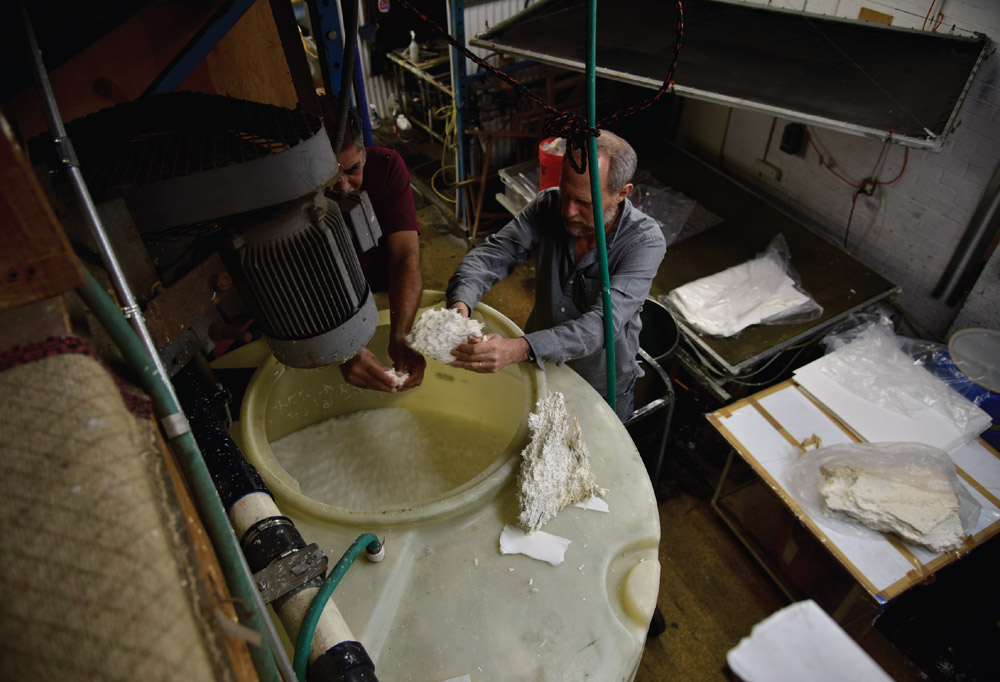
“Paper.” Post-agitation, Director Shaye Remba and Head Preparator Salvador Campos check Mixografia’s handmade paper for consistency and quality.
Untitled Ultra Blue would be delightful and impressive enough had Martin made it using blue cake icing on cotton paper, or more conventionally, like his other works, paint layered onto a smooth substrate. But as with so many Mixografia productions, including six hundred unique editions by nearly ninety artists with whom the studio has collaborated since its inception, viewers must make a focused effort to recall they are in fact not looking at a painting or sculpture, but a print in the most fundamental sense of the term. The Untitled Ultra Blue included in Mixografia: Est. 1969 is indeed one impression out of an edition of an identical 25, all ostensibly composed of intense, ultramarine oil paint squeezed out and layered upon handmade paper, but in actuality made with studio-mixed ink transferred onto studio-produced paper whose convincing, three-dimensional aspects (which at their most extreme stand in relief more than 3.1 centimeters) are alternating depressed and protuberant patterns—not oil paint on paper at all, but integral parts of the surface itself. The sui generis effect upon viewers is that of a double frisson: first as a result of experiencing the exquisite richness, saturation, texture, and detail of the piece; and then as one remembers (and tries to fathom how) these qualities were realized using just ink and paper.
While no two Mixografia editions are alike, with sizes, subjects, and styles as variable as the aesthetic projects of the artists who designed and created them at various junctures during the past fifty years, Martin’s work at the retrospective is characteristic in terms of the arresting effect it tends to elicit (“That’s a print?”), but also the signature process used to make the piece. Also called Mixografia, and nearly as old as the studio itself, the printmaking technique was singular enough to compel husband and wife cofounders Luis and Lea Remba to apply for a United States patent in 1977 (granted in 1979), and was described somewhat colorlessly at the US Patent and Trademark Office as a “process for making artistic prints.” As such, in descriptions on Mixografia’s website and elsewhere, the registered trademark sign (®) sometimes follows the term: since the late 1970s, Mixografia processes have in fact been registered more than thirty times by the patent offices of eight nations.
Mixografia’s story actually begins in Mexico City, half a continent away from the studio’s current location at the southern edge of downtown Los Angeles, and as indicated by the title of last year’s retrospective, half a century ago. There and then, following their serendipitous acquisition of a slightly damaged social realist painting while on a trip to the Teotihuacan pyramids in search of Mesoamerican antiquities (and, just as serendipitously, meeting and consulting with the artist about how to restore it), Luis and Lea befriended Pablo O’Higgins—the American expatriate and colleague of Diego Rivera who cofounded Mexico’s Taller de Gráfica Popular in 1937. Aware of and affected by the quality of the work at Luis’s father’s commercial print shop located on Mexico City’s Plaza de Santo Domingo, it was O’Higgins who first suggested the Rembas use the space, equipment, and Luis’s printmaking know-how in order to make art.

“Plate.” Printer Rodrigo Montoya applies ink to select areas of a Mixografia plate to be used in the production of Ed Ruscha’s 2014 Rusty Signs series.
In 1969, Luis and Lea opened the Taller de Gráfica Mexicana, a precursor to Mixografia that corresponded with the latter enterprise, not only in how Luis collaborated with artists to help determine the technical means by which to make their prints, but also by way of the studio serving as a gallery space overseen and marketed in large part by Lea, who also helped to organize the Taller de Gráfica Mexicana’s inaugural exhibit that same year. A solo retrospective that ran from July 7–August 4, 1969, the exhibit featured engravings and lithographs by Leopoldo Méndez, who had just died in February, and who had cofounded the Taller de Gráfica Popular with O’Higgins and fellow Mexican artist Luis Arenal Bastar thirty-two years earlier.
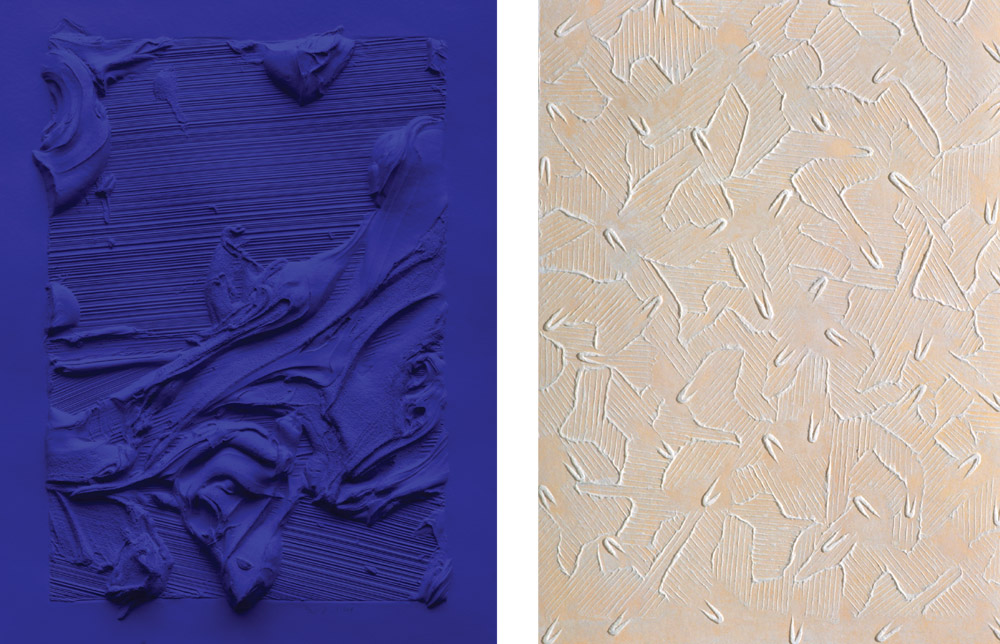
Jason Martin, Untitled Ultra Blue, 2014, Mixografía.® | Seo-Bo Park, Ecriture Series I – 20, 1994, Mixografía.®
While the genesis of the Mixografia studio can be traced to the Rembas’ print shop on the Plaza de Santo Domingo and O’Higgins’s influence and encouragement, the patented Mixografia process owes its existence to the collaborations that were obtained at the Taller de Gráfica Mexicana and the creative restlessness of Rufino Tamayo. In 1973, the Rembas approached Tamayo about the possibility of working together to create an edition of prints, but the artist demurred. Essentially an elder statesman of Mexican printing and an accomplished maker of woodcuts, engravings, and lithographs, by the early 1970s Tamayo wanted to utilize more expressionistic modes and techniques, and was certain the traditional kinds of printing being undertaken at the Taller de Gráfica Mexicana would preclude making art with the sort of texture, palpability, and surface detail he desired.
Undeterred, with Tamayo’s requirements in mind—and marshaling his training as a mechanical engineer and experience as a lithographer—Luis invented a printing process in which he produced a three-dimensional copper printing plate from Tamayo’s model. In a high-pressure roller press the resultant matrix, onto which ink is applied and into which moist paper is forced, allowed for the kind of three-dimensional qualities Tamayo sought. As the never-before-seen printing process mixed together elements from allied graphic arts techniques, Tamayo and Luis alighted upon a Spanish neologism that telegraphed this salience: Mixtografia—a term that became Mixografia upon the artist and printmaker’s conclusion that the former word might be difficult to pronounce, and perhaps especially so for non-Spanish speakers.
The initially reluctant Tamayo would go on to produce close to eighty editions of Mixografia prints before his death in 1991. His earliest Mixografia prints are stylistic syntheses, featuring the traces and shadows of figures that could be said to resemble Tamayo’s Modernist (and particularly Cubist) paintings from earlier in the century, but whose subjects and style also derive quite clearly from Mesoamerican pictographs and petroglyphs. Though not always warm, and executed with a deliberately limited color palette, the inks are typically vivid and intense (Octavio Paz once wrote of Tamayo’s paintings, “The sun is in all his pictures, whether we see it or not”), with textured lines that appear scratched into nonexistent paint or plaster, and negative spaces characterized by irregular, at turns jagged, pockmarked, and “crackled” surface details in relief. One encounters in these prints, then, an indication of the sorts of dimensional and chromatic possibilities later Mixografia artists have explored and deployed, including editions like Martin’s gestural “cake frosting” works and other prints whose ink-and-paper subjects are depicted so realistically one can rightly qualify them as trompe l’oeil.
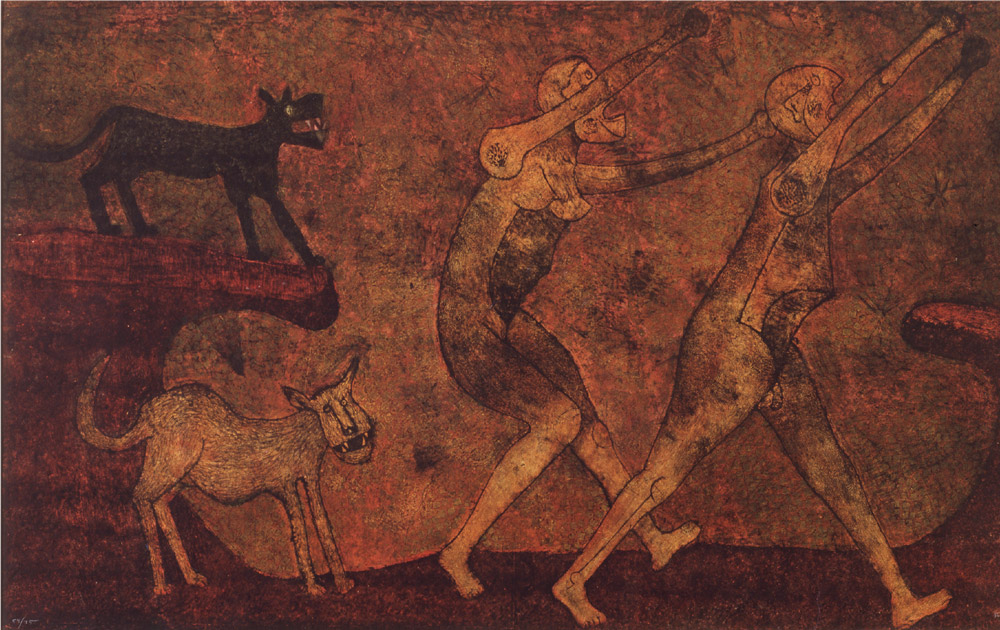
Rufino Tamayo, Dos Pesonajes Atacados Por Perros, 1983, Mixografía.®
Tamayo’s quite literal magnum opus with the studio—a colossal Mixografia and lithograph print from 1983 called Dos Personajes Atacados Por Perros—is such an exploration. A kind of secular expulsion featuring a simultaneously primitivist and robotoid Adam and Eve fleeing in terror from two ferine dogs, the print’s rich copper and gold tones combined with a small, square-shaped grid pattern stamped randomly across its surface give the appearance of a bas-relief having been hammered into bronze—an ostensible artifact from the extinct culture of a future past. Viewers of the piece at Mixografia: Est. 1969 who needed convincing about the work’s true composition and origin, or were skeptical that a single lithograph of such gigantic proportions could even be produced, needed only to glance to their right to see the 2.6 × 1.6 meter lithography stone from which the image was printed. The largest conventional lithography stone in the world—and in some ways a cornerstone of the studio’s story and enterprise—the talismanic object hangs prominently and permanently in a specially-designed rig in Mixografia’s Los Angeles gallery.
The Rembas moved Mixografia from Mexico City to Los Angeles in 1984, a year after printing Dos Personajes Atacados Por Perros and fifteen years after they launched the Taller de Gráfica Mexicana. Impelled in part by the first years of the long financial crisis in Mexico that came to be known as La Década Perdida, and eager to open a new market for Mixografia in the US, they were also encouraged by Robert H. Gray, Dean of Fine Arts at the University of California, Los Angeles. Following a Mixografia exhibition at UCLA’s Wight Art Gallery in 1981, Gray proposed that a Mixografia studio in Los Angeles could serve as the working space for an artist-in-residence program at the school, and, as a bonus, expand Mixografia’s purview, influence, and potential for collaborations beyond the Americas.
Gray’s vision never materialized, but by the mid-1980s this latter motivator was arguably unnecessary: In the nearly ten years since the creation of Mixografia, the studio had earned an international reputation for working with master artists to actualize ambitious visions, and in more than a few instances, inventing entirely new processes when existing techniques and materials proved inadequate. In these endeavors and their new adopted city, the Rembas were joined by their son Shaye, a mechanical engineer like his father and also a key figure in Mixografia’s first years in Mexico. Once overseer of the workshop and since 2011 Mixografia director, Shaye, among other innovations, designed and built the beaters that make the unique, color-absorbing cotton paper that is able to endure the high pressures of the enormous presses (which he also helped design and build) whose massive steel rollers are literally repurposed axles from diesel locomotives. Like the art itself, for printmaking students and practitioners, Mixografia’s remarkable custom equipment and machines have an air of mystery and surprise; for the artists with whom they collaborate, the monumental technology and the studio’s impressive oeuvre evinces the Rembas’ singular acumen and inventiveness, revealing a real sense that the most important element in any potential Mixografia project may simply be the will to try.
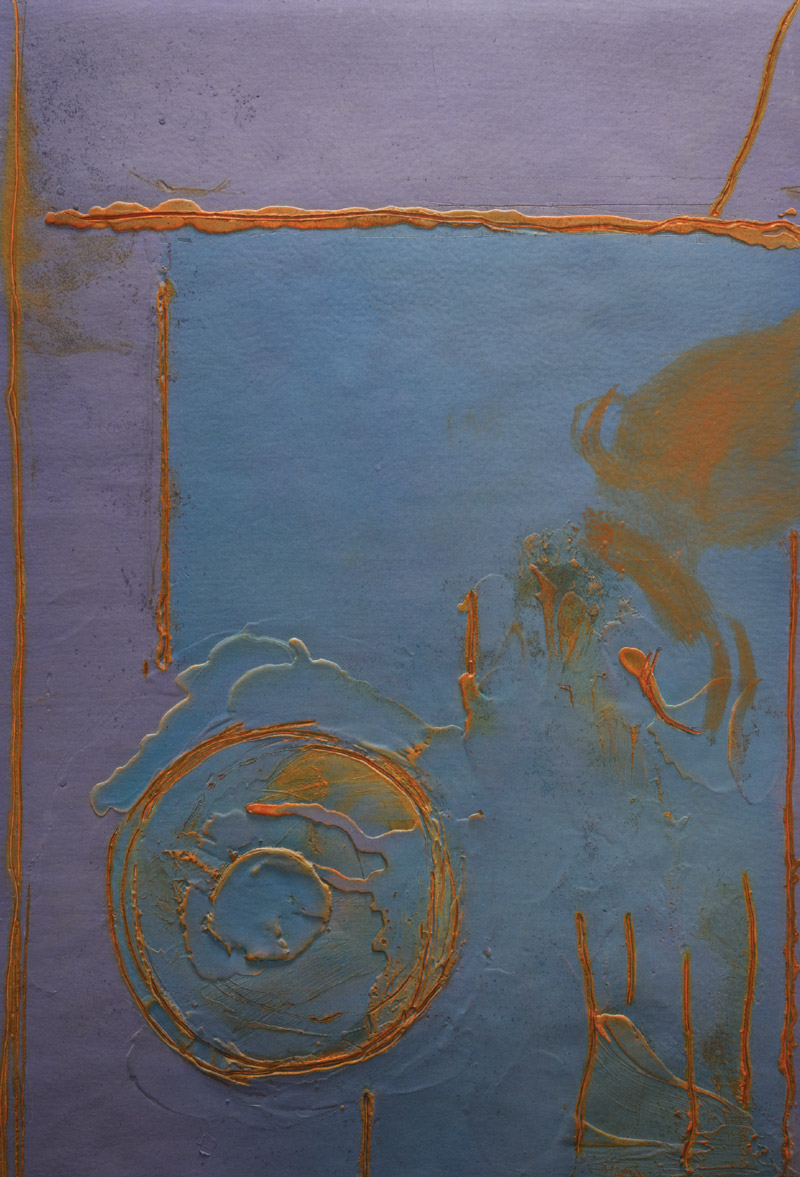
Helen Frankenthaler, Guadalupe, 1989, Mixografía.®
From the first at the Los Angeles studio, these elements have attracted artists with vastly different styles and aesthetics—the late John Baldessari, Alberto Burri, Kwang Young Chun, Robert Graham, Helen Frankenthaler, Jacob Hashimoto, Frank Romero, Kiki Smith, and Rachel Whiteread, to name just a few. Some have sought verisimilitude, as with prints like Louise Bourgeois’s Crochet, I-V (1998); Ed Ruscha’s New Wood, Old Wood (2007); Baldessari’s Concrete Couples (2015); and Analia Saban’s clothing label prints from 2019, which respectively mimic—with double-take-inducing accuracy—crimson yarn arranged in looped patterns on white paper; a just-milled two-by-four plank hovering near its long-weathered twin; nine cement sidewalk squares into which historical and fictional romantic partners have traced their names; and oversized, fabric tags complete with tattered edges and embroidered lettering. Others have seized upon the nuanced surface details and vivid tones afforded by the Mixografia process to produce more abstract and conceptual explorations, as with Frankenthaler’s textured Color Field prints (1989); Seo-Bo Park’s ribbed Ecriture series (1994, 1997, and 2002); Lynda Benglis’s Color Echoes (2000); Alex Israel’s neon self-portraits (2017); and Jonas Wood’s ostensible collages of orchidacea, the punnily named Three Clippings (2018).

Ed Ruscha, New Wood, Old Wood, 2007, Mixografía.®
With so many prints on display, one upshot of Mixografia: Est. 1969 was to transmit the variety, and the variability of the prints the studio has produced over the decades. But a commonality emerged as viewers recognized Mixografia artists’ manifest interest in processes adapted from traditional printmaking techniques, and their concomitant desire to expand beyond these techniques’ restrictions and limitations. A joyful, boundary-pushing spirit may be the most accurate and unified way to think not only about the Mixografia process—which perforce demands we trouble the constraints of print, and more generally, the usual distance between media and that which it represents—but also the venture itself, wherein the distinction between artist and printmaker is sometimes difficult to discern, and the studio (simultaneously laboratory, workshop, and publication place) is a more generous, versatile, and accessible space than one might associate with fine art concerns. This openness is captured in the capacious on-site gallery where Mixografia: Est. 1969 took place. Contrary to the often rarefied atmosphere of many showrooms, and perhaps owing to Mixografia’s populist roots in Mexico, the space has been open to the public since first opening in 2016, and meant to instruct as much as delight.
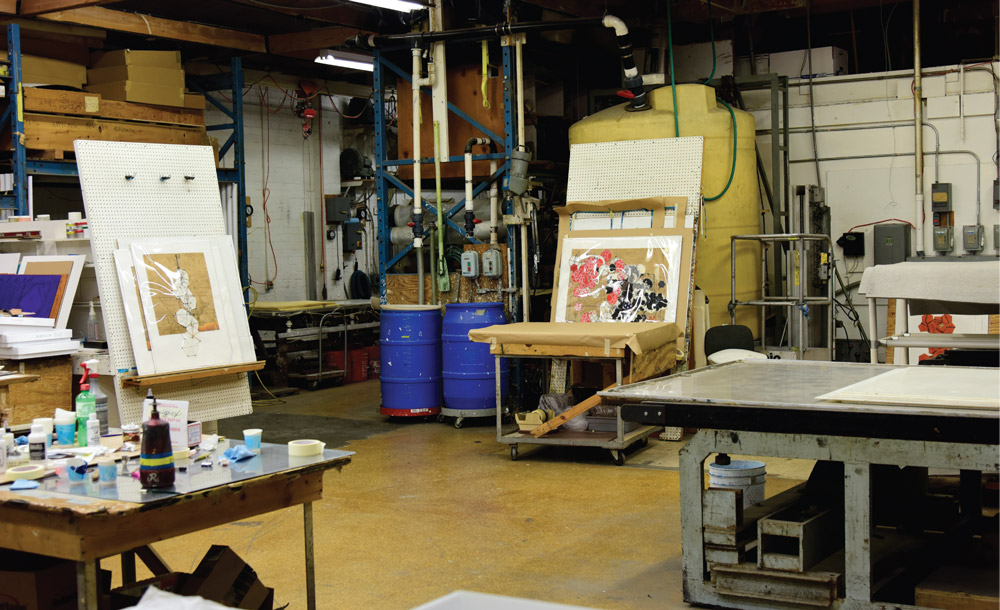
“Workshop.” A detail of the Mixografia workshop, featuring paper vats, one of several colossal presses, inks and solvents, and a print by Jacob Hashimoto in various stages of completion.
As such, among the many attendees at Mixografia: Est. 1969 were numerous art students, alternatively marveling at the prints on display and consuming the agua fresca, tequila, and tacos the Rembas provided (perhaps in another nod to their populist Mexican roots) in lieu of wine and cheese. Like the other guests, the students were fulfilling an aspiration: In an August 2016 interview, Luis noted a main purpose of the then-new gallery was “to educate people about different printmaking processes,” before adding, of the studio he founded, “We want to revive the printmaking process.” And to the extent that it has represented an ever-evolving take on the processes, products, and reception of fine printmaking, while bestowing a new kind of life in building upon and pushing beyond former parameters, Mixografia is regenerative, indeed.
